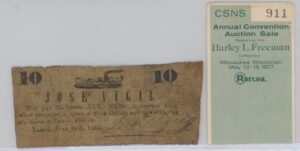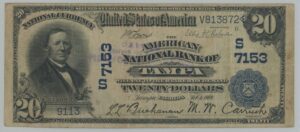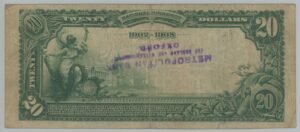TAMPA

In 1823, the United States imposed upon the leaders of the Seminoles to sign the Treaty of Moultrie Creek, which created a large Indian reservation in the interior of peninsular Florida. The U.S. government then built a series of forts and trading posts throughout the territory to enforce the provisions of the treaty.
As part of this effort, Fort Brooke was established on January 10, 1824 by Colonels George Mercer Brooke and James Gadsden at the mouth of the Hillsborough River on Tampa Bay, just about where today’s Tampa Convention Center sits in Downtown Tampa. The site was marked by a huge hickory tree set atop an ancient Indian mound most likely built by the Tocobaga culture centuries before. Colonel Brooke, the outpost’s first commander, directed his troops to clear the area for the construction of a wooden fort and support buildings, but ordered that several ancient live oak trees inside the encampment be spared to provide shade and cheer. On January 22, 1824, the post was officially named Fort Brooke.
A few settlers established homesteads near the palisade, but growth was very slow due to difficult pioneer conditions and the constant fear of attack from the Seminole population, some of whom lived nearby in an uneasy truce. In December 1835, troops led by Major Francis L. Dade were ambushed by on their way from Fort Brooke to Fort King (near present-day Ocala) in a rout that was dubbed the Dade Massacre. The Second Seminole War had begun.
During the war, Fort Brooke first served as a refuge for settlers, then as a vital military depot and staging area. After almost seven years of vicious fighting, the war was over and the Seminoles were forced away from the Tampa region, and the tiny village began a period of slow growth.
A strong hurricane in late September 1848 almost washed away the budding growth. Every building in Tampa was either damaged or destroyed, including most of Fort Brooke. Much of the population stayed to rebuild, and some desperate lobbying in Washington, DC persuaded the US Army to reconsider a plan to abandon the fort and its garrison of troops.
The Territory of Florida had grown enough by 1845 to become the 27th state. The settlement of Tampa recovered enough by 1849 to incorporate as the “Village of Tampa”, which officially occurred on January 18. At the time, Tampa was home to 185 inhabitants, excluding military personnel stationed at Fort Brooke. The city’s first official census count in 1850 listed Tampa-Fort Brooke as having 974 residents. Tampa was reincorporated as a town on December 15, 1855, and Judge Joseph B. Lancaster became the first Mayor in 1856.
Evidence of the young community’s growth was seen as its first churches appeared. Tampa’s first church was established by a Methodist congregation in 1846. That downtown church, First United Methodist Church of Tampa, is still active today. The Methodists were followed by the Baptists, who organized the First Baptist Church of Tampa in 1859, and the Catholics, who founded a parish in Tampa the following year.
Source: Wikipedia
Burr & Lynch, Tampa Bay (written date of September 18, 1837)

1837 6 1/4 Cent Note
Joseph Burr Jr. and James Lynch together issued “Tampa Bay” scrip with the date of September 18, 1837. The only known denomination is 6 1/4 Cent scrip.
J.S. Redbrook (circa 1862)

Partial 50 Cent Scrip J.S. Redbrook
Large size scrip only known note on this issuer features a sailboat, gunboat and two-mast steamship. UNIQUE
C.R. Mobley (engraved dates of 1862, Orange Spring Style)

1862 50 Cent Note
from Harley L. Freeman Collection

1862 $1 Note
Benice-3
PCGS Fine 15
Producing notes similar to the “Orange Spring” style, C.R. Mobley was probably a merchant who issued his own scrip. He is a vague character in historical books with little known of his past.
Jose Virgil (written dates, engraved 1862)

1862 5 Cent Note
from Harley L. Freeman Collection

1862 10 Cent Note
from Harley L. Freeman Collection

1862 25 Cent Note

1862 25 Cent Note

1862 50 Cent Note
from Harley L. Freeman Collection
Jose Vigil produced scrip dated June 26, 1862 using the “Orange Spring” style. Vigil was a successful business owner who thrived throughout the 1860’s eventually selling his business and moving his family to New Orleans.
First National Bank of Tampa (3497)

First National Bank Building Post Card

First National Post Card

 1882 Brown back $5 Note Signed by T.C. Taliaferro, cashier and John N.C. Stockton as president
1882 Brown back $5 Note Signed by T.C. Taliaferro, cashier and John N.C. Stockton as president
Charter #3497

 1902 Date Back $5 Note Signed by Richard J. Binnicker, cashier and Thomas C. Taliaferro, president
1902 Date Back $5 Note Signed by Richard J. Binnicker, cashier and Thomas C. Taliaferro, president
Charter #3497

 1902 Date Back $10 Note
1902 Date Back $10 Note
Charter #3497

 1902 Date Back $20 Note Signed by R.J. Binnicker, cashier and Douglas F. Conoley as assis. president
1902 Date Back $20 Note Signed by R.J. Binnicker, cashier and Douglas F. Conoley as assis. president
Charter #3497

1902 Plain Back $5 Note Signed by R.W. Masters, cashier and R.J. Binnicker, president
Charter #3497

1902 Plain Back $10 Note Signed by R.W. Masters, cashier and R.J. Binnicker, president
Charter #3497

1902 Plain Back $20 Note Signed by R.W. Masters, cashier and R.J. Binnicker, president
Charter #3497

1929 Type 1 $5 Note Signd by R.W. Masters, cashier and R.J. Binnicker, president
Charter #3497

1929 Type 1 $10 Note Signed by R.W. Masters, cashier and R.J. Binnicker, president
Charter #3497

1929 Type 1 $20 Note
Charter #3497

1929 Type 2 $5 Note
Charter #3497

1929 Type 2 $5 Note
Signed E.C. Schoen & E.P. Taliaferro, III as pres.
Charter #3497

1929 Type 2 $10 Note Signed by R.W. Masters, cashier and R.J. Binnicker, president
Charter #3497

1929 Type 2 $10 Note Signed by E.C. Schoen, cashier and E.P. Taliaferro, president
Charter #3497

1929 Type 2 $20 Note Signd by R.W. Masters, cashier and R.J. Binnicker, president
Charter #3497

1929 Type 2 $20 Note Signed by E.C. Shoen, cashier and E.P. Taliaferro, president
Charter #3497
The First National Bank of Tampa was opened with an initial $50,000 after being issued a charter on May 6, 1886. The first elected President of the bank was John N.C. Stockton who lasted less than three years turning the duties over to Daniel G. Ambler. Thomas C. Taliaferro was hired as cashier, his brother James P. Taliaferro took over the role of President after Daniel G. Ambler lasted only two years. In 1976 the bank adopted a new name, First National Bank of Florida, the bank is the oldest national bank still open and serving customers.
Gulf National Bank of Tampa (4478)

$10 and $20 Proof Sheet
Source: Smithsonian Florida Proof Project
On December 2, 1890 a charter was issued to Gulf National Bank of Tampa. Before falling into receivership in July of 1893 they issued only $15,750 worth of Brown Back notes, none of which are known to be in existence today.
The Tampa National Bank (4539)

$5 Proof Sheet
Source: Smithsonian Florida Proof Project
The Tampa National Bank was chartered on March 26, 1891 and was shortly then liquidated in May of 1892. There are no known notes from this bank still in existence.
Exchange National Bank of Tampa (4949)

Exchange National Bank Building Post Card

Exchange National Bank of Tampa Armored bank truck

 1882 Brown Back $5 Note
1882 Brown Back $5 Note
Signed J.B. Anderson, Cash. & John Trice, Pres.
Charter #4949

 1882 Brown Back $10 Note Signed by Alonzo C. Clewis, president and J. Arthur Griffin, cashier
1882 Brown Back $10 Note Signed by Alonzo C. Clewis, president and J. Arthur Griffin, cashier
Charter #4949

 1882 Brown Back $20 Note Signed by J. Arthur Griffin, cashier and Alonzo C. Clewis, president
1882 Brown Back $20 Note Signed by J. Arthur Griffin, cashier and Alonzo C. Clewis, president
Charter #4949

 1882 Date Back $5 Note
1882 Date Back $5 Note
Signed J.A. Griffin, Cash. & Eduardo Manrara, Pres.
Charter #4949

 1882 Date Back $10 Note
1882 Date Back $10 Note
Signed J.A. Griffin, Cash. & Eduardo Manrara, Pres.
Charter #4949

 1882 Date Back $20 Note
1882 Date Back $20 Note
Charter #4949 Signd by J.A. Griffin, cashier and A.(Alonzo) C. Clewis, president

 1902 Date Back $10 Note
1902 Date Back $10 Note
Charter #4949 Signed by J.A. Griffin, cashier and A.C. Clewis, president

 1902 Date Back $20 Note
1902 Date Back $20 Note
Charter #4949

1902 Plain Back $5 Note
Charter #4949 Signed by John O. Perry, cashier and J.A. (Arthur) Griffin, president

1902 Plain Back $5 Note
Charter #4949 Signed by T.(Thomas) G. Mixon, cashier and J.A. Griffin, president

1902 Plain Back $10 Note
Charter #4949 Signed by T.G. Mixon, cashier and J.A. Griffin, president

1902 Plain Back $20 Note
Charter #4949 Signed by T.(Thomas)G. Mixon, cashier and J.A. Griffin, president

1929 Type 1 $5 Note
Charter #4949

1929 Type 1 $10 Note
Charter #4949 All 1929 series notes were signed by T.G. Mixon, cashier and J.A. Griffin, president

1929 Type 1 $20 Note
Charter #4949

1929 Type 2 $5 Note
Charter #4949

1929 Type 2 $10 Note
Charter #4949

1929 Type 2 $20 Note
Charter #4949
The Exchange National Bank of Tampa was chartered on March 21, 1894 and opened with a $100,000 capital. John Trice was elected President along with the help of J.B. Anderson, cashier. The Exchange National Bank exists to this day under its original national charter.
American National Bank of Tampa (7153)

1902 Red Seal $20 Note
Charter #7153 Signed by L.L. Buchanan, cashier and M.(Melville) W. Carruth, president

 1902 Date Back $10 Note
1902 Date Back $10 Note
Charter #7153

1902 Plain Back $10 Note
Charter #7153


1902 Date Back $20 Note Charter #7153

1902 Plain Back $20 Note
Charter #7153
The American National Bank of Tampa began with a capital of $250,000 and was issued a charter on March 1, 1904. The elected president of the bank was Melville W. Carruth and L.L. Buchanan assigned cashier duties. The Bank eventually failed in 1929 after attempting a merge with Citizens Bank and Trust Co. a decade earlier.
National City Bank of Tampa (10958)

1902 Plain Back $5 Note (With geographical letter “S”)
Charter #10958 Signed by C.B. Dekle, assistant cashier and Jamie Pendas, vice president

1902 Plain Back $ Note (Without geographical letter)
Signed Chas. B. Galloway, Cash. & Charles A. Faircloth, Pres.
Charter #10958

1902 Plain Back $5 Note
Signed “Assistant” Cashier C.B. Dekle
Charter #10958

1902 Plain Back $10 Note
Charter #10958
Signed Chas. B. Galloway, Cash. & Charles A. Faircloth, Pres.

1902 Plain Back $10 Note
Charter #10958
Signed Chas. B. Galloway, Cash. & Charles A. Faircloth, Pres.

1902 Plain Back $20 Note
Charter #10958
Signed Chas. B. Galloway, Cash. & Charles A. Faircloth, Pres.

1902 Plain Back $20 Note
Charter #10958
Signed Chas. B. Galloway, Cash. & Charles A. Faircloth, Pres.
The above set of notes shows representations of each denomination with and without the Geographical Letter “S” for Southern area States. The Gold Standard Act of March 14, 1900 spawned the organization of thousands of new National Banks all accross the country. This made the task of sorting notes in the redemption bureau increasingly burdensome. To aid in the sorting, the country was divided into six geographical areas. The geographical letter corresponding to the area in which the bank was located was overprinted on the face of the notes, in this case the letter “S” for 14 Southern area States, including Florida, was assigned. Notes issued between March 17, 1902 and March 14, 1924 were overprinted with the appropriate geographical letter (N;E;M;S;W;P were used). The use of these letters ended when more efficient sorting methods made them unnecessary.
The National City Bank of Tampa began with a capital of $300,000 on February 21, 1917. Charles A. Faircloth was entrusted as President along with W.B. Coarsey to handle the duties of cashier, replaced by C.B. Galloway in 1922. March 30, 1929 National City merged with First National Bank.












































































